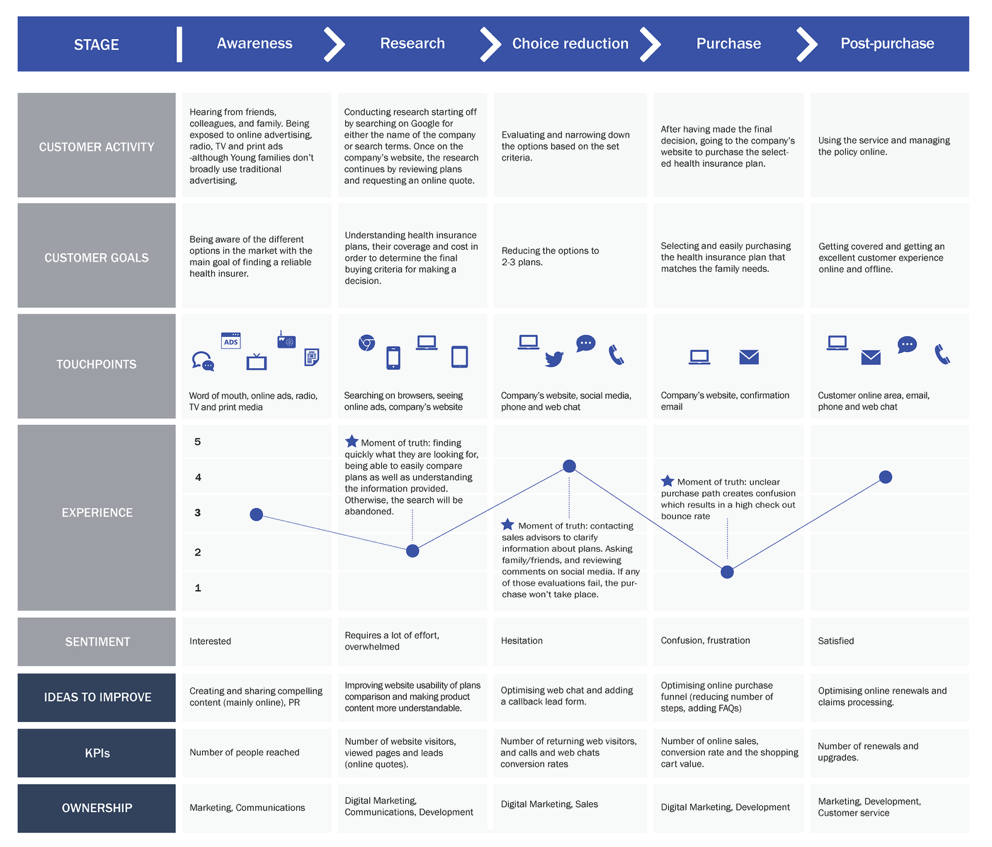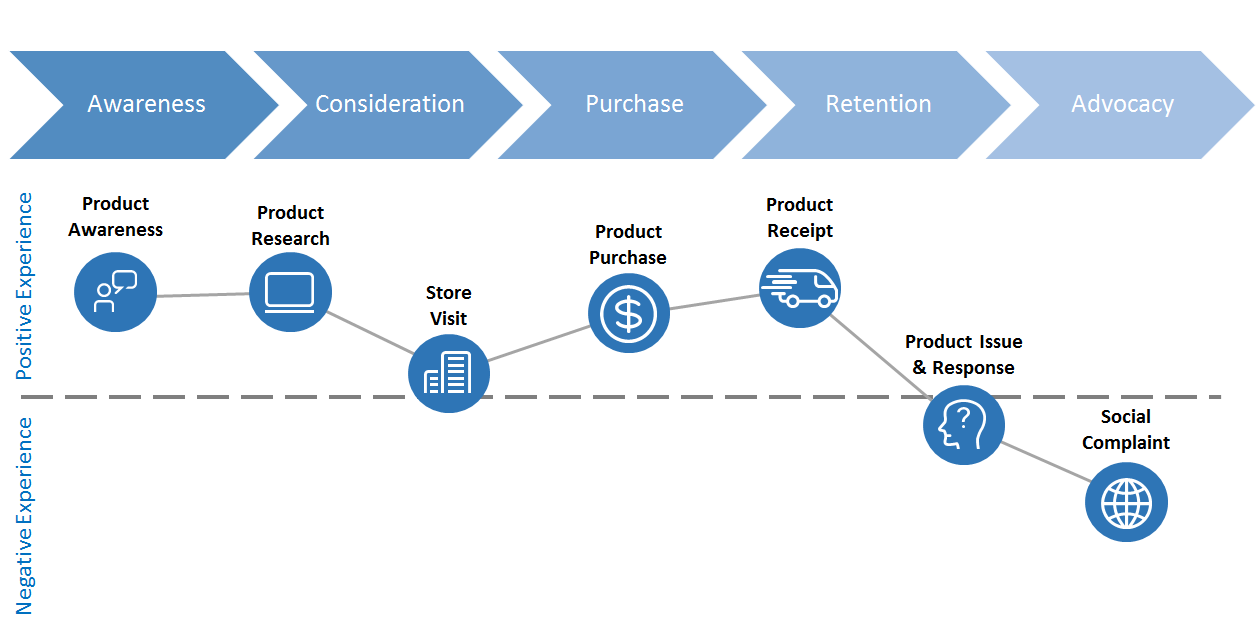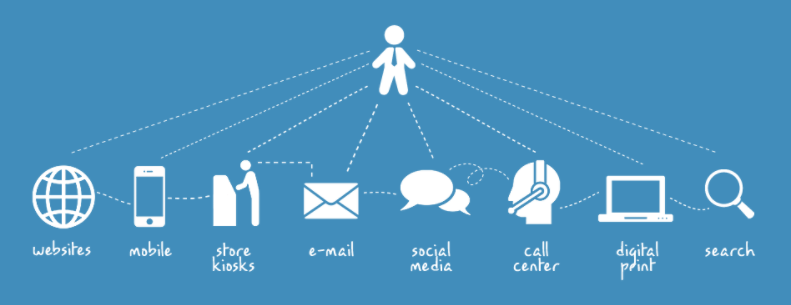Customer Journey Map
The Basics of Killer Journey Maps
Customer Journey Map is a tool that helps marketers identify, organize, verify, and socialize the customer experience. It also helps marketers understand what customers need by discovering gaps in the customer experience (CX)Opens in new window. They subsequently use these learnings to research and propose solutions to these gaps.
The goal of a Customer Journey Map is to create a visual story about how people interact with your brand. Journey Maps act as a bridge of understanding between the brand and the customer.
As well as helping to overcome the Empathy GapOpens in new window, Journey Maps will empower your executives to work cross-fucntionally and iron out all of your experience issues. The resulting CX work will increase margins and shareholder value.
But before we get too carried away with the results, let’s set a few parameters for the output.
The 6 Keys to an Effective Customer Journey Map
As any framework, the specific sections and verbiage will differ from brand to brand. But if your Journey Map includes the following you’re on the right track:
- Customer Persona
- Purchase journey (also known as Path to Purchase) divided into specific steps or phases.
- Touchpoints customers will interact with or use during their experience
- A specific goal and the actions a customer must take to accomplish it
- Detail regarding the customer’s needs, pain points, and emotional state during each step of their purchase journey
- Opportunities for the brand to better address customer pain points and frustrations
The template below is a graphical example of what a Customer Journey Map looks like. We’ll do a deeper dive into each components listed above.
 Graphics courtesy of CX That SingsOpens in new window
Graphics courtesy of CX That SingsOpens in new window
|
Taken separately, the pieces of this Journey Map aren’t too helpful. They may help you improve a tactic here or there. However, put these together, and the Journey Map becomes a potent tool — giving you a peek into the real-world experience of your customers, and a high-level visual of their holistic journey. It’s from this starting place that you can create a truly breakthrough customer experience for your brand.
A Deep Dive Into the Sections of the Customer Journey Map
- Persona
A marketing persona is a semi-fictional representation of a group of your customers. Based on research and data from your existing customers, a persona is a heuristic that represents an essential segment of your buyers.
Personas bring your customers to life through both demographic and psychographic details. Although they aren’t always.
Limit Journey Maps to the experience of one persona and their path toward one primary goal.
As stated earlier, the primary goal of a CJM is to bring clarity to an ambiguous buying process. If you try to capture every single customer and every journey they take in one map, you’ll miss the signal in the noise.
We have discussed at length the process of creating a Persona in designated post, but here you can find an example below:
 A Buyer Persona | Template courtesy of OBERLOOpens in new window
A Buyer Persona | Template courtesy of OBERLOOpens in new window
|
- Phases of the Purchase Journey (aka Path to Purchase)
This section outlines the high-level process customers follow from awareness to purchase, and beyond. In real life, this isn’t a linear journey, and different sections might overlap. However, for the sake of illustration, we divide the journey into discrete and step-wise parts.
In consumer brands, there tends to be a 4 – 6 phases in a purchase journey. In practice, you may include more, less, or different phases in your map. It all depends on your particular industry, product, and customer type.
A B2B software procurement journey will look very different from someone thinking about where to eat lunch. So while the framework below is a good starting place, your purchase journey will likely look different than this basic template.
 A Purchase Journey | Template courtesy of MediumOpens in new window
A Purchase Journey | Template courtesy of MediumOpens in new window
|
- Touchpoints
A point of contact, interaction, or information gathering. Touchpoints can be owned by the brand (such as a TV ad or website), or reflect the brand experience in some way (such as Social Media or online reviews).
Be sure to note touchpoints used during Moments of Truth (see point #8 below) in your Journey Map.
These Moment of Truth Touchpoints have the highest potential for impact on your customer experience. Below you’ll find a snip from our example Journey Map of the touchpoint section:
 Touchpoints of CX | Source: Business 2 CommunityOpens in new window
Touchpoints of CX | Source: Business 2 CommunityOpens in new window
|
- Customer Actions, Thoughts, and Verbatims
Capturing the combination of what customers do, think, and feel is why Journey Maps are so useful. Customer verbatims (quotes) help us understand how people perceive our CX efforts and how we can improve their experience.
In our example Customer Journey Map, Customer Actions would include things like:
- Google reviews, blog walkthroughs
- Get a cost of ticket quote on the JRPass site
- Browse JR site and relevant “How to book” blogs
- Browse regional passes
- Cross-check with planned trip – vet Osaka-Tokyo Hokuriku Arch Pass
- Select ticket and purchase tickets
- Wait for ticket to arrive in mail
- Check email for delivery updates
- Download the app as a fail-safe option
Verbatim help us understand how our customers are expressing their experience. These are the quotes that provide insight into our CX challenge. In this example journey, the verbatim include:
|
- Pain Points
Here we capture the most significant hurdles, challenges, or issues that customers have when trying to accomplish their mission. Each pain point will be bucketed into a part of the Purchase Journey and associated with a touchpoint (or lack thereof).
While performing qualitative research to construct your journey Map, you’ll find that customers are pretty straightforward with their complaints. The challenge will be using data and further analysis to decide which (of likely many) of these to include.
The customer pain points may include the following concerns:
|
- Emotional Journey
This is the secret sauce that makes Customer Journey Maps especially helpful. By understanding the peaks and valleys in your customer’s emotions, you’ll identify those areas where your experience is outstanding, and where it could use some work. Combine that emotional insight with customer pain points and you have a powerful mix of data.
 Emotional Journey | Source: docs.idew.orgOpens in new window
Emotional Journey | Source: docs.idew.orgOpens in new window
|
- Ideas / Opportunities
This section is where you can build on the pain points, emotional journey, and customer feedback to start painting a picture of the future. Often these areas act as thought starters for more robust projects or CX initiatives. This journey map include ideas such as:
|
- Moments of Truth
The moments in which your brand has the most significant opportunity to influence customer decision or action. These typically occur when the customer first encounters your product, when they purchase your product, use it, and then react to how it works.
Moments of truth might also be related to the peaks and ends of your experience, as these are the moments that create customer memories of your experience.
Five (5) Guiding Principals for a Killer Customer Journey Map
Customer Journey Maps may vary in specific sections and design, but they all share several guiding principals:
- They’re written from the customer’s point of view, not the company’s. The purpose of the Journey Map is to close the Empathy Gap between marketer and consumer. This can be tricky to do from inside an organization. That’s why it is recommended brands hire an agency to build their Journey Maps, to get the benefit of an outsider’s view.
- They combine the mechanics of an experience with the customer’s emotional respons. Here’s where the magic happens. The magic of Journey Maps doesn’t come from just documenting a customer’s experience. It comes from combining this with the intangible layer of emotions and perceptions of a customer. One without the other is a story without substance (or vice versa).
- They document the customer’s omnichannel journey. Journey Maps capture how people use multiple touchpoints (not just a website or retail store, for instance). From a customer’s view, every interaction is part of one big experience. There’s no online or offline, above-the-line or below it. It’s just one company, one product, and one experience.
- They are visualization tools, first and foremost. The challenge of managing the customer journey is a hughe one, but the reward is equally big. To get buy-in for CX initiatives, you’ll need everyone on the same page regarding pain points, challenges, and opportunities. The visual nature of the CJM has two benefits. One, everyone gets closer to understanding the complexities of your customer experience. Two, you can use it as a socialization tool to gain alignment and buy-in from internal partners.
- They define and capture the phases of the customer purchase or experience journey. Ultimately, customer experience initiatives need to drive ROI. By aligning the Journey Map to a customer path with a -measurable goal, you can keep everyone focused. Without this high-level target, it’s easy to get lost in tactical initiatives that drive short-term action but no long-term gains.
See Also:
- Jennifer L. Clinehens, CX That Sings: An Introduction to Customer Journey Mapping

